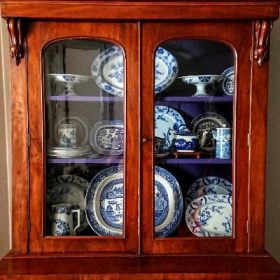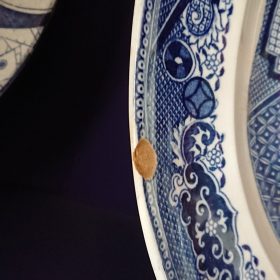
A few days ago while out walking I discovered a little atelier where a young French woman does restoration work. Small statues, pottery, china. Outside, through the tiny boutique’s window, I marveled at a cherub’s fragile finger that had been beautifully and perfectly repaired on a delicate little statuette in unbaked porcelain (called “biscuit” in French). On a hunch, I entered the shop.
I was thinking of the enormous English turkey platter I managed to bring here from the States so many years ago. It was my Mum’s, inherited from her favorite, distant cousin, Isabelle Cloudsley, from Scotland.
Isabelle died when I was only two, but I do remember her in a shadowy way, her silhouette mostly, as she grandly entered our house with her fashionable umbrella and feathered hat. To this day only Eleanor Steber ever wore longer pheasant feathers in her hat.
The platter is still beautifully brilliant, just like new really, and never had the slightest scratch, even though it endured family Thanksgiving dinners for many years, sometimes for up to 24 in our little home: with tables set up in the kitchen, extra card tables for the kiddies in the dining room, besides Mum’s wonderful cherry drop-leaf table for twelve. And even card tables in the living room!
But my mother always proudly took great care of the heirloom dish. Most of the time, she kept her platter safely in the back of a wooden cupboard in the kitchen. Since it is very large, of course it always rubbed against something, especially when you move things around. It was my fault that one day, probably 50 years ago, I miscalculated – by its weight and it’s presumed resistance to shock – and inflicted a little chip on the edge.
Like that of Amfortas, in ‘Parsifal,’ the wound was an untreatable injury to my soul as well as to the platter, which had long gone untended and hidden from view, like some of our deepest wounds that lie hidden from public view. I don’t think Mum ever saw the nick; for her, those days of cooking for 24 were now long over…
I brought the platter here under my arm on the plane in 1994, when Mum closed the house in Pavilion, and have always proudly displayed it in an enormous mahogany cabinet, using a camouflage technique of putting another plate just in front of the nick. And of course I kept adding to the collection : gifts offered to me, souvenirs from traveling (Meissen from Halle, Minton from Monte Carlo, even several pieces from Asia), “finds” in flea markets across New York State. But it always irked me that such a beautiful piece as “Isabelle’s plate” should be marred, destined to second podium status so to speak.
Well, the restorer, named Marine, made a special deal with me, a favor between artists, let’s say, and I delivered the project to her the next day.
After dropping off the platter, and just after leaving her little shop, standing in the sunlight and checking both ways to cross the narrow cobblestone street, I thought I heard the familiar strains of the beginning of the Adagio from Mozart’s clarinet concerto in A Major. Recognizable of course among the most beautiful melodies every humanly crafted. The calming, soothing sounds and the timbre of the clarinet are always a balm to the soul. And when the orchestra enters in unison, it’s to me as if this aching world were for one moment at peace.
But that morning, looking around to try to figure out where this ensorcelling music was coming from, I couldn’t tell if it was from someone’s window, or from a passing car… The amazing thing is that it was immaterial, unable to be grasped with anything or by any tool in my earthly possession. It’s uncanny, but this spot is also just steps from where Mozart lived when he first came to Paris.
My eyes started to fill with happy tears: I had just performed a long put-off, overdue action that would address repairing a wound that had been left unattended, ignored, hidden. I was rendering justice to the people who loved me or trusted me enough to give me the platter, and putting my trust in the hope that a future generation might appreciate, by one person’s example, the value of Beautiful Things.
Pier-Luigi Pizzi once spoke to me about great people he had known. He said to me that “The dead, the departed, continue to watch over and protect us.” I thoroughly agree, and also feel that protecting and preserving what we love, those people – and those things – that we have learned to cherish, is still of primary importance in my life.
It was a pleasure to pick up the plate this morning, of all things to happen on the day of my birthday, and bring “Isabelle’s plate” back home again. I suppose I did it for my mother, too, and maybe for a future generation I’ll never meet.
Because those passed on before us DO continue to protect us.
***Marine FargettonInstagram / @marinefargettonAtelier
ManuFactVillage Saint Paul15, rue Saint Paul 75004 Paris
Tél / 06 89 74 75 11




